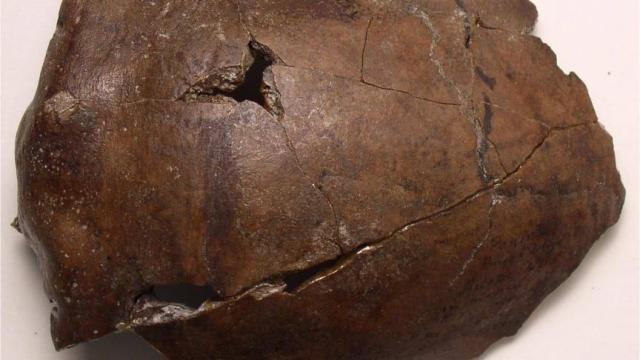A 6000-year-old skull found in Papua New Guinea is the earliest record of a human killed in a tsunami, according to new research published this week.
Image: Arthur Durband
Back in 1929, Australian geologist Paul Hossfeld uncovered a partial human skull outside the coastal town of Aitape in Papua New Guinea. An international team of scientists recently returned to the site in an effort to find out what might have killed this individual.
Their analysis, which now appears in PLOS One, shows that the skull was buried in sediments bearing the distinctive characteristics of an ancient tsunami. “[We] conclude that the skull was laid down in a tsunami deposit and as such may represent the oldest known tsunami victim in the world,” write the researchers in the study.
The partial skull is only one of a few early skeletal remains uncovered in the area, and it was originally thought to belong to an archaic human species known as Homo erectus. More reliable carbon dating placed it to between 5000 and 6000 years old, which means it most certainly belonged to a modern human.
In 2014, a team led by James Goff, an anthropologist from the University of New South Wales and first author of the new study, returned to the spot, Paniri Creek, where the skull was originally found in hopes of finding new evidence. Ninety years ago, Hossfeld didn’t bother to record any local evidence, such as taking soil samples or analysing the stratigraphic layers, and instead wrote a field description that, at the very least, included information about where the skull fragment was unearthed.
“What we were doing was actually going in and sampling the sediments to bring back for lab analysis that would tell us a lot more about the age and depositional history there,” said co-author Mark Golitko, an assistant professor of anthropology at the University of Notre Dame, in a statement. “We were able to use modern scientific techniques to understand a little more about how this place formed and what we were actually looking at.”
The researchers conducted a chemical analysis of the dirt and sediment found in-and-around the site, while also measuring the size of the grains. Importantly, they also discovered the presence of preserved diatoms — small, single-celled aquatic creatures that can be used to paint a picture of what water conditions were like at the time.
When diatoms die, they form a tiny shell around them and then sink to the bottom. Goff’s team put the sediment under a microscope and counted the diatoms, which allowed them to determine the temperature, salinity, and energy of the water when they died.
“These sediments that the Aitape skull was in have pure marine diatoms in them, which is ocean water that’s inundating it,” explained Golitko. “It’s really high-energy ocean water — high-energy enough for these little tiny specks of silica that the diatoms build to be broken as they’re washing in.”
These three things combined — the high-energy water, the chemical signatures, and the grain sizes of the sediment — strongly suggest the presence of a tsunami at the time the skull was buried.
“We have now been able to confirm what we have long suspected,” said Goff. “The geological similarities between the sediments at the place where the skull was found and sediments laid down during the 1998 tsunami that hit this same coastline have made us realise that human populations in this area have been affected by these massive inundations for thousands of years.”
The authors say the Aitape individual was either violently killed by the ancient tsunami, or their grave was ripped apart by a tsunami, leading to their head — but not the rest of the body — being brought out to sea and then back to shore where it was buried among the incoming debris. But this “grave” theory, say the researchers, isn’t likely.
Despite this ancient tsunami, people continued to live along this part of the Papua New Guinea coast. Looking ahead, the researchers would like to learn more about how people lived in the area at the time and in the periods following this natural disaster to see how they might have responded to these risks. As the researchers conclude in their study:
[Tsunamis] may have contributed to a much more dynamic world of community and individual mobility and an increasing reliance on risk-mitigation strategies including the fostering and maintenance of wider-ranging social ties … [playing] a significant role in the spread of materials and new ideas and practices throughout the [southwest] Pacific as documented in the mid-Holocene archaeological record.
So as destructive as tsunamis have been (and continue to be), these recurring natural disasters may have actually brought communities together, pushing human development forward. In this case, it was one step back, two steps forward.
[PLOS One]
